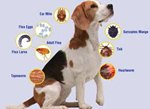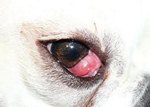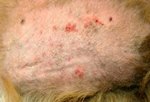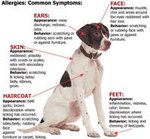HEALTH CONCERNS

- Severe disease that affects the internal organs; can spread to people
- Causes: A bacterium which is often carried by rodents, that enters through mucous membranes and spreads quickly throughout the body.
- Symptoms:
Less severe: fever, vomiting and loss of appetite
More severe: shock, irreversible kidney damage and possibly death

RABIES
- Potentially deadly that infects warm-blooded mammals. Not seen in United Kingdom
- Causes: Bite from a carrier of the virus, mainly wild animals
- Symptoms:
1st stage: dog exhibits change in behaviour, fear
2nd stage: dog’s behaviour becomes more aggressive
3rd stage: very clumsy, cannot control body functions (poo, pee, saliva)

PARVOVIRUS
- Highly contagious virus, potentially deadly
- Causes: Ingestion of the virus, which is usually spread through infected dogs
- Symptoms: severe diarrhoea, vomiting, fatigue, lack appetite

KENNEL COUGH
- Contagious respiratory infection (affects the lungs)
- Causes: Combination of types of bacteria and virus. Most common are Bordetella bronchiseptica bacteria and parainfluenza virus
- Symptoms: severe cough

DISTEMPER
- Disease primarily affecting breathing and nervous system
- Causes: Virus that is related to the human measles virus
- Symptoms:
Less severe: fever, lack of appetite and mucous secretion progress
More severe: brain damage, ‘hard pad’

HEPATITIS
- Virus primarily affecting the liver
- Causes: Canine adenovirus type (CAV-1). Enters system when dog breathes it in
- Symptoms:
Less severe: include listlessness, diarrhoea, vomiting
More severe: include ‘blue-eye’ (clumps of virus in eye)

CORONAVIRUS
- Virus resulting in digestive problems
- Causes: Virus is spread through infected dog’s faeces
- Symptoms: stomach pain, shown by lack of appetite, vomiting, diarrhoea

MANGE
- Mites cause a skin irritation called mange
- Some are contagious such as cheyletiella, ear mites, scabies and chiggers
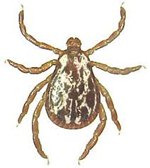
TICKS AND MITES
- Bite like fleas, they can’t jump nor fly but crawl
- They harpoon - dig their nose into the dog’s skin and drink the dog’s blood
- Dogs can get Lyme disease. Most dog get ticks from 1 week to 6 months depending on the climate
- How to prevent/treat ticks, mites and fleas with Frontline:
Using FRONTLINE Spot On:
Step 1
Use FRONTLINE Spot On regularly to kill adult fleas on your pet.
- In severe infestation, apply FRONTLINE Spot On every 4 weeks for 12-16 weeks to bring the flea population under control.
Step 2
Make sure all dogs are treated.
- Each pet in your household can act as a host for a flea infestation.
Step 3
Regularly vacuum your carpets and furnishings and wash your pet's bedding above 60C
- The will help to reduce the number of any eggs, larvae and pupae in the environment.
Step 4
Use an environment spray containing an Insect Growth Regulator.
- This will kill eggs and larvae that are developing in the home environment.
Step 5
Allow treated pets continued access to infested areas.
- Fleas that hatch out from pupae in the home can then jump onto your treated pet and be killed through contact with FRONTLINE Spot On. No insecticidal treatment kills pupae so this is important step.
Note: It’s normal to continue to see fleas on your pet after treatment as new adult fleas continue to hatch out from pupae in the home environment. These new fleas will be killed within 24 hours of jumping onto your treated pet.
|
INTERNAL PARASITES
|
Roundworms |
|
Hookworms |
|
|
Tapeworms |
|
|
Heartworms |
|
|
EYE DISEASES
|
Conjunctivitis |
|
Dry Eye Syndrome |
|
|
Prolapse of the gland
of the third eyelid |
|
|
Corneal Disease |
|
|
Uveitis |
|
|
Glaucoma |
|
|
Cataracts and lens
dislocation |
|
|
Retinal disease |
|
|
Optic nerve |
|
|
SKIN DISORDERS
|
Inherited Skin Disorders (from parent to child) |
|
Auto-immune Skin Disorders (allergic to yourself) |
|
|
ALLERGIES
|
Airbone Allergies
(allergies transferred by air / breathing) |
|
|
Food Allergies and Intolerance (cannot eat some types of food) |
OTHER HEALTH-RELATED ISSUES
DENTAL HEALTH
- Nylon, safe edible and dental chews are good for dental health and plaque
NEUTER / SPAYING
- If your dog is not competing, this is recommended.
- Benefits: Training is easier. Dog has less desire to mate and can focus
- Females do not have unplanned pregnancies, and no ovarian or uterine cancers
- Males have reduced risk of testicular tumours and prostrate cancer
VACCINATING
- Not recommended for ill or pregnant dogs, and avoid for elderly dogs
- Crippled dogs, dogs under surgery, dogs on any drugs that weaken the immune system should not be vaccinated
POO POO SYSTEM
- If you see your dog dragging his backside on the ground due to itch, the backside can be infected
- There are two things that have to be empty when your dog poos: anal sac and bowel
- If the sacs are not emptied, it creates a lot of pain for the dog. Your vet and groomer can empty the anal sacs easily
For more information, please refer to:

Publisher: Kennel Club Books in the USA or Interpet Publishings, UK
